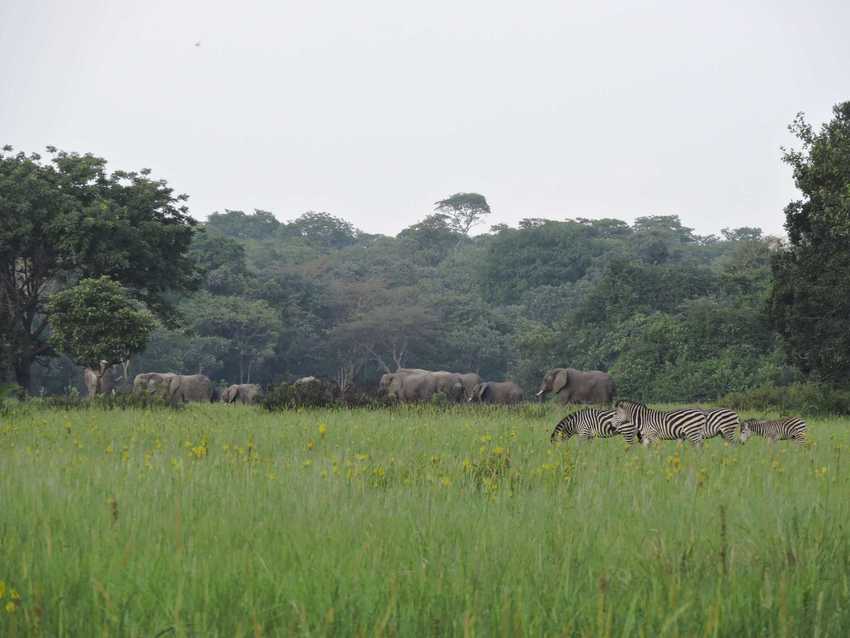Elephants and Zebra roam at Kasanka. Image credit: Kasanka Trust.
It’s relatively small, it doesn’t have the Big 5 and you may not even have heard of it. So why are we so passionate about supporting conservation projects in and around Zambia’s Kasanka National Park? We asked Richard Peel, General Manager of our local partner, Kasanka Trust, to explain why this little green corner of Africa is so important…
INTERVIEW BY WILLIAM GRAY
Many people have heard of Lower Zambezi and South Luangwa National Parks in Zambia. What makes Kasanka so special?
Kasanka is a little-known park because it doesn’t have lots of big game animals like Lower Zambezi and South Luangwa that first-time safari goers seek out. What makes Kasanka so special is actually far more impressive. Kasanka is home to one of the largest mammal migrations and greatest wildlife spectacles on earth. From October to December every year about 10 million straw-coloured fruit bats migrate from across central Africa to Kasanka, and roost in a 25-hectare patch of wet evergreen forest in the centre of the park. The bats can be seen leaving their roost at dusk against spectacular sunsets and huge thunderstorms to feed on abundant indigenous fruits in the surrounding landscape. Guests are woken at 3:30am to see the bats return from their foraging excursions, dodging avian predators such as crowned, martial and fish eagles before they settle down to roost for the day.
Straw-coloured Fruit Bats leaving their Kasanka roost at dusk. Image credit: ©Frank Willems
What’s your ‘Kasanka Big 5’?
I have never really thought of a Kasanka Big 5. If I were to choose five species that make Kasanka special to me they would be Straw-coloured Fruit Bat, Sitatunga, Sable, Crowned Eagle and Elephant.
If you could choose one month to visit Kasanka, which would it be?
December. Early in the rainy season the park is still fully accessible, the bush is emerald green and full of new life, and the bats are still here in their millions. Every day is spectacular!
What’s the one migrant bird species you most look forward to seeing return to Kasanka each summer?
Osprey. As an ichthyologist I am perhaps biased toward piscivorous birds.
Birds and bats aside, what is the most memorable sighting you’ve enjoyed in Kasanka?
My most memorable wildlife encounters in Kasanka aside from bats have been elephant related. This is because they often raise the adrenaline levels. Kasanka’s elephants have bad crop raiding habits, and farmers regularly chase them from their fields. So, when one encounters a bull in the park, they can be a bit cheeky. Most recently I spent two hours trapped on a causeway with water on both sides. A large bull was standing in the middle of the road browsing on reeds. He mock-charged, coming to within a few metres and towering over the vehicle we were trapped inside. He calmed down after a few minutes and went back to browsing reeds but refused to get off the road and let us pass for a very long time.
Following the collapse of global tourism due to the COVID-19 pandemic, what are the short- and long-term impacts on Kasanka?
To be honest we are yet to feel the full impact of the pandemic in Kasanka. Our tourism season is centred around the bat migration from October to December, during which we make about 80% of our revenue. We are still holding out hope that we will have some form of tourism during the upcoming season. Should the local situation deteriorate between now and October we may find ourselves in a very difficult position financially. Tourism revenue makes up the bulk of our core funding. Without it we may be forced to reduce management staff capacity, which will in turn have a negative impact on the various donor funded conservation and community development projects that we are undertaking. We are hoping for the best but preparing for the worst by implementing new fundraising strategies to mitigate against the loss of core funding.
10 million Straw-coloured Fruit Bats migrate to Kasanka, providing one of nature’s amazing spectacles for lucky observers. Image credit: ©Frank Willems.
About Richard Peel
I am Zimbabwean born but moved to Zambia in 2004 after my parents lost their farm to the land invasions in 2002. I finished my schooling in Zimbabwe and went straight to university in South Africa right up until I finished my PhD in Ichthyology and Fisheries Science in 2016. After finishing our PhDs my partner Geraldine and I moved back to Zambia from our field site in north-eastern Namibia. Several months of fruitless job searching went by before we decided to volunteer our services to the Kasanka Trust. It was the best way of getting a foot in the door.
We started in February 2017, volunteering in Lavushi Manada National Park which was managed by the Kasanka Trust at the time. The Trust was going through a challenging period and after six months in Lavushi Manda, in August 2017, Geraldine and I moved to Kasanka to help the team here. Later that year the Trust decided to withdraw from Lavushi Manda as it could no longer afford to sustain operations there. I was asked to be General Manager of Kasanka Trust in December 2017.

